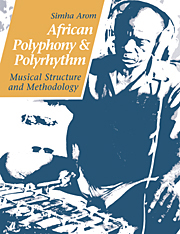Book contents
- Frontmatter
- Contents
- List of illustrations
- Foreword by György Ligeti
- Preface
- Acknowledgements
- BOOK I THE MUSIC OF THE CENTRAL AFRICAN REPUBLIC
- BOOK II AFRICAN POLYPHONIC MUSIC
- BOOK III TECHNICAL TOOLS: METHODS OF RECORDING POLYPHONIC MUSIC FOR TRANSCRIPTION
- BOOK IV THEORETICAL TOOLS
- BOOK V THE ORGANISATION OF TIME IN AFRICAN MUSIC
- BOOK VI STRUCTURAL PRINCIPLES AND THEIR APPLICATION
- Conclusion
- Bibliography
Preface
Published online by Cambridge University Press: 27 January 2010
- Frontmatter
- Contents
- List of illustrations
- Foreword by György Ligeti
- Preface
- Acknowledgements
- BOOK I THE MUSIC OF THE CENTRAL AFRICAN REPUBLIC
- BOOK II AFRICAN POLYPHONIC MUSIC
- BOOK III TECHNICAL TOOLS: METHODS OF RECORDING POLYPHONIC MUSIC FOR TRANSCRIPTION
- BOOK IV THEORETICAL TOOLS
- BOOK V THE ORGANISATION OF TIME IN AFRICAN MUSIC
- BOOK VI STRUCTURAL PRINCIPLES AND THEIR APPLICATION
- Conclusion
- Bibliography
Summary
When I got off the plane in Bangui, the capital of the Central African Republic, on 30 November 1963, it was the first time I had ever set foot on the African continent. I had no idea that this date was to mark a turning point in my career.
The country was celebrating the anniversary of its independence on the following day, 1 December. Groups from several provinces were to put on shows of traditional music during the festivities. Within twenty-four hours, I was thus able to make myself acquainted with a variety of the types and techniques of the country's music.
At the time I was a performing musician and played the French horn in a symphony orchestra. For me, as for many Europeans in the 1960s, there was no ‘real’ music outside Western music. I was conditioned by a cultural background too narrow to allow easy comprehension of anything as different and as disconcerting (in the etymological sense of the word) as African music. I thus found myself suddenly plunged into a universe of sound which was as strange to me as it was unexpected: there were groups of percussion instruments playing tightly interlocked rhythms, orchestras of up to twenty wind instruments in which each musician would play only a single note in an extremely strict and precise polyphonic latticework, choirs singing incredibly complex and yet perfectly coherent contrapuntal music, and many other surprises. Everything was performed from memory with no conductor to provide coordination. The extent to which the performers were apparently unconstrained was equally bewildering.
The result of this first encounter was ‘love at first sight’.
- Type
- Chapter
- Information
- African Polyphony and PolyrhythmMusical Structure and Methodology, pp. xix - xxviPublisher: Cambridge University PressPrint publication year: 1991



